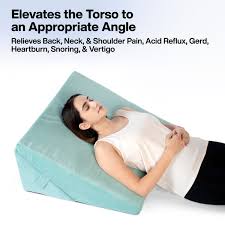

In today’s tech-driven world, forward bent neck, also known as forward neck syndrome or neck forward head posture, has become a common issue.
This condition is characterized by the head leaning forward relative to the shoulders, causing strain on the neck and upper back. People often search for ergonomic solutions to correct neck posture and alleviate discomfort.
One such solution that has gained attention is the wedge cushion, particularly the bed wedge pillow and headboard pillow wedge.
But the question remains: Can a wedge cushion really fix your forward bent neck?
In this article, I would explore how a wedge cushion might help with forward neck posture, delve into scientific evidence, and ultimately determine if it is an effective solution.
“Can a Wedge Cushion Really Fix Your Forward Bent Neck” Article Index:
- Understanding Forward Bent Neck: What is It?
- How Forward Neck Syndrome Develops
- The Role of Wedge Cushions in Correcting Neck Posture
- Types of Wedge Cushions: Headboard Pillow Wedge vs. Bed Wedge Pillow
- Can a Wedge Cushion Really Fix Forward Neck Posture?
- Scientific Evidence Behind Wedge Cushions and Forward Bent Neck
- FAQs on Wedge Cushion to Fix Computer Neck
- Conclusion: Is a Wedge Cushion the Solution for Forward Bent Neck?
Understanding Forward Bent Neck: What is It?
Forward bent neck, also referred to as forward leaning neck or forward neck syndrome, is a condition where the head moves forward, causing a misalignment of the cervical spine.
This posture places added stress on the neck and upper back muscles, leading to pain, stiffness, and even headaches.
People with a sedentary lifestyle or those who frequently use mobile devices are particularly prone to this condition.
Over time, if left unaddressed, forward neck posture can lead to more serious issues like herniated discs, nerve compression, and chronic musculoskeletal pain.
Therefore, correcting neck posture is essential not only for comfort but also for long-term health.
How Forward Neck Syndrome Develops?
Forward neck syndrome develops gradually due to prolonged poor posture, particularly when sitting or using devices.
Activities like typing on a computer, texting, or even reading in bed often encourage a forward leaning neck.
This constant strain on the muscles and ligaments around the cervical spine eventually leads to postural misalignment.
In many cases, individuals are unaware that they are suffering from forward posture until pain and discomfort become too severe to ignore.
The increased pressure on the spine, especially in the C7 vertebra, can lead to long-term spinal issues if not corrected.
The Role of Wedge Cushions in Correcting Neck Posture
A wedge cushion is designed to provide ergonomic support, helping align the spine and alleviate pressure points while sleeping or sitting.
It creates an angled surface that elevates the upper body, encouraging better posture and reducing strain on the neck.
The idea is that by using a wedge cushion, especially while resting or lying down, you can fix forward neck posture by keeping the spine in its natural alignment.
For individuals with forward bent neck, using a wedge cushion can help relieve the tension in the cervical spine by promoting a more upright posture.
The gradual shift in sleeping or resting posture can reduce the forward leaning neck position over time, leading to improvements in both comfort and alignment.
Types of Wedge Cushions: Headboard Pillow Wedge vs. Bed Wedge Pillow
There are various types of wedge cushions, each designed for different purposes. The most common are:
Headboard Pillow Wedge:
This type of wedge cushion is used in bed, placed against the headboard to elevate the upper body. It supports the neck and shoulders, making it easier to maintain correct posture while reading or watching TV in bed.
It is particularly useful for individuals who experience neck discomfort due to improper resting positions.
Bed Wedge Pillow:
Similar to the headboard pillow wedge, a bed wedge pillow is placed under the upper body while sleeping.
It elevates the torso, reducing the strain on the neck and promoting proper spinal alignment.
People with forward posture, particularly those suffering from acid reflux or sleep apnea, often find this type of pillow helpful for maintaining a healthy neck posture while sleeping.
Pillow Wedge for Sleeping:
This wedge cushion is specifically designed for individuals who need more neck support while sleeping.
By elevating the head and neck, it helps align the cervical spine, thus reducing the risk of forward neck syndrome.
The pillow wedge for sleeping is especially beneficial for those looking to correct neck posture during rest.
Can a Wedge Cushion Really Fix Forward Neck Posture?
The short answer is: it can help.
A wedge cushion is not a magic cure for forward neck syndrome, but it can be a valuable tool in promoting better posture and reducing neck strain.
By encouraging an aligned spine, a wedge cushion can alleviate the pressure on the cervical spine caused by forward posture, ultimately helping to fix forward neck posture over time.
However, using a wedge cushion alone is not enough. It is important to combine it with other measures, such as neck exercises (neck stretches), ergonomic adjustments to your workspace, and mindfulness about posture throughout the day.
A 2020 study published in the Journal of Physical Therapy Science emphasizes the need for a holistic approach to posture correction, including ergonomic aids like wedge cushions along with physical therapy for optimal results.
Scientific Evidence Behind Wedge Cushions and Forward Bent Neck
Several studies have highlighted the benefits of ergonomic aids, such as wedge cushions, in promoting proper posture.
Research from The Spine Journal in 2018 found that individuals using wedge cushions while sleeping experienced a reduction in neck pain and improvements in overall spinal alignment. While the study did not specifically focus on forward neck syndrome, it demonstrated that proper alignment while resting can have a positive impact on posture-related issues.
Moreover, a 2019 study published in Clinical Biomechanics showed that wedge cushions, particularly bed wedge pillows, improved the neck’s natural curvature and relieved symptoms of neck forward head posture.
The study concluded that using a wedge cushion can support proper cervical spine alignment during sleep, which can indirectly help fix forward neck posture.
These studies suggest that while a wedge cushion can assist in improving posture, it’s most effective when combined with other interventions like physical therapy and consistent ergonomic practices.
FAQs on Wedge Cushion to Fix Computer Neck
Q-1: How does a wedge cushion help correct forward head posture?
A-1: A wedge cushion promotes proper spinal alignment by tilting the pelvis forward, encouraging the spine to straighten and the head to align over the shoulders. This reduces strain on neck muscles and ligaments, aiding in the correction of forward head posture.
Q-2: Is the effectiveness of wedge cushions supported by scientific research?
A-2: Yes, research has shown that wedge cushions can improve posture. Studies involving school children demonstrated that using a wedge-shaped cushion led to significant improvements in seated posture, supporting their use for posture correction.
Q-3: How long should I use a wedge cushion daily to see results?
A-3: Consistent daily use is important. Even as little as 10 minutes a day can help begin correcting forward head posture by gradually training the body to maintain better alignment.
Q-4: Are wedge cushions suitable for all ages?
A-4: Wedge cushions are generally suitable for individuals of all ages. They are designed to fit most seating situations and can be used by both adults and children to promote better posture and reduce discomfort.
Q-5: Can wedge cushions alleviate neck and shoulder pain associated with forward head posture?
A-5: Yes, regular use of wedge cushions helps restore proper spinal alignment, which can reduce muscle strain and alleviate neck and shoulder pain linked to forward head posture.
Q-6: Are there any limitations to using wedge cushions for correcting forward head posture?
A-6: While wedge cushions are helpful, they may not fully correct severe postural issues on their own. In such cases, additional interventions like physical therapy or ergonomic changes may be necessary for optimal results.
Q-7: How do wedge cushions compare to other posture correction devices?
A-7: Wedge cushions offer a non-invasive and cost-effective way to improve posture. They can be used alone or alongside other posture correction methods to enhance overall effectiveness.
Conclusion: Is a Wedge Cushion the Solution for Forward Bent Neck?
So, can a wedge cushion really fix your forward bent neck?
The answer is that while it can significantly help, it is not a standalone solution. As per bestforwardheadposturefix.com, “A wedge cushion, whether it is a headboard pillow wedge or bed wedge pillow, can promote better spinal alignment and reduce the strain on your neck”.
By encouraging proper posture during rest, it can alleviate the symptoms of forward posture and assist in correcting neck posture over time.
However, achieving lasting results requires a multi-faceted approach. In addition to using a wedge cushion, it is crucial to incorporate posture-correcting exercises, ergonomic adjustments, and mindfulness into your daily routine.
Addressing the root cause of forward neck syndrome, such as poor habits during sitting or sleeping, is essential for long-term improvement.
For those dealing with forward bent neck, a wedge cushion can be a practical and effective tool, but it should be part of a broader strategy to fix forward neck posture and maintain spinal health.
References:

